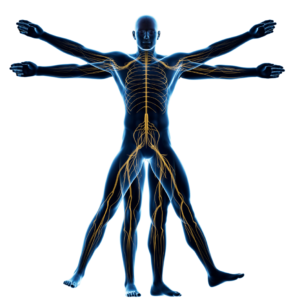Proprioception is a word that is associated with balance, however many people don’t know exactly what it means let alone why it is discussed with balance. This article explains what proprioception is and how it helps us to stay balanced.
Close your eyes and touch your index finger to your nose. What sense did you use to do this? Your eyes were closed, you didn’t “feel” your way to your nose through physical touch and you certainly didn’t use taste or smell to get there! This activity was an example of proprioception and should highlight how commonly it is used in our everyday life.
The formal definition of proprioception is the sense that lets you perceive the location, movement and the actions of parts of the body. Put briefly, it is often termed our “position sense” and it helps us to control our body movements. Proprioception is the combined effort of signals from the receptors in our muscles, skin and joints that detect changes in stretch and tension and help to determine the necessary output from the muscles. This output involves not only the coordination of which muscles need to be working or relaxed, but also how much force is needed.
Our muscles have two different types of sensory receptors that help with proprioception. The muscle spindles are in the middle of the muscle belly and are sensitive to changes in the length of the muscle which cause a signal to fire up to the brain. In the connection between the muscle and its tendon, there is a receptor called the Golgi Tendon Organ (or GTO for short) which detect changes in muscle tension. Most people have seen this receptor in action if you have ever been to a health professional who has used a reflex hammer on the tendon below your knee. A fast tap on the tendon increases its tension very rapidly and produces a protective contraction of the muscle which causes your leg to extend involuntarily afterwards. For both of these receptors, the speed of the change in length or tension has a large bearing on the body’s response.
The joint capsule, ligaments and skin have a different type of receptors which again are sensitive to stretch and also pressure. These receptors detect directional changes in stretch in the skin, and are most active at the end range limits of joint movement.
The collective information from the sensory receptors described above is then used by the brain to determine our body position and what forces are acting on it. Much like the GPS in our car or on our smart devices, the positioning system relies heavily on good quality input from the receptors. Most people have experienced the frustration of a loss of signal from our GPS when our satellite connection is poor. This can make it extremely difficult to navigate to our target destination. In the same way, reduced or delayed input from the receptors makes movement harder for the body to control.
Like many other parts of the body, our sensory receptors abide by the “use it or lose it” rule. They are also affected by damage from injury (including surgery such as joint replacements). Another factor which can affect proprioception is systemic inflammation which can reduce our proprioception and impair our muscle strength and balance. The good news is there are 2 easy ways to keep these receptors healthy:
- Movement – making sure that we move the joints and the muscles in all of their possible ranges stimulates the receptors and draws blood flow to them.
- Texture – the skin receptors are especially sensitive to differences in texture. Where safe, walking barefoot on different textured surfaces such as tiles, grass, carpet can be good to expose the receptors to different stimuli which makes them more active.

